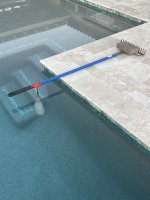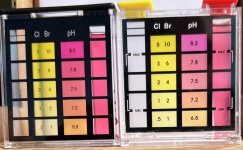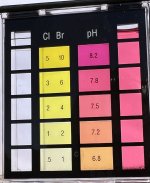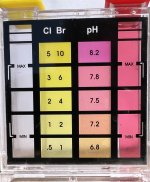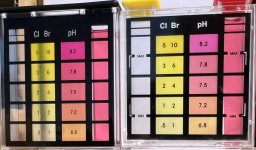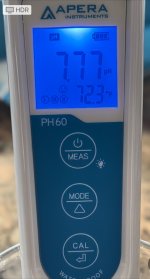- Sep 4, 2022
- 340
- Pool Size
- 15400
- Surface
- Plaster
- Chlorine
- Salt Water Generator
- SWG Type
- Pentair Intellichlor IC-40
I added CYA by putting in knee high, suspending it in front of a return. After it got mushy I squeezed it out and brushed in the area. It worked very well.Are you clear on how to add CYA? I once burned my brand new pebble finish doing it wrong! (Using liquid, which is why I shout about not using liquid!!!)
- End CYA at 70, but like you're adding salt, shoot for low and creep your way up to it, giving a few days between dosing. If you're due for a filter cleaning, do that first. You don't want to clean the filter for a few weeks after adding solid CYA to the skimmer in a sock. (DON'T USE LIQUID CYA!)
- Keep SWG off until salt test result is stable for at least 24 hrs.
- Yes, install water temp probe.
- Leave TA alone. Mine was very high, and I battled it to no avail. My acid additions brought it down eventually and it has been stable since.
- Turn Snoopy (Evo 614iQ) loose.
- I expressed salt all over the pool once. What a chore that was! I now pour it all into as small a pile as possible in the shallow end, and sweep it onto itself, keeping the pile as small as possible. Repeat until gone.
- Yes, run OCLT and confirm it passes.
- Yes, run complete set of tests and adjust as needed for targets as per TFP guidelines. Some of us prefer to run our FC a little high, to keep from ever getting near our minimum. I run mine at 7 with a 70CYA.
Yes, turn on SWG and confirm it registers salt a day or two after you added the last of the salt (NOT before).- Yes, set SWG for 40% and determine min rpms to generate, add 200 rpms to set floor for SWG. Test periodically. Use liquid chlorine to reestablish your target if necessary. Don't try to reestablish your target by goosing the SWG for a while. You'll never get off of the roller coaster. Test, bump with LC, adjust SWG up a bit. Repeat until a few tests result in a stable FC. Expect to repeat that a few times as it warms up.
- Yes, definitely celebrate with a nice Opus X Lost City cigar and glass of neat angels envy rye whiskey
!
Would there be any concerns dumping the salt on our Baja ledge in front of the return and brushing it all around on the ledge as it dissolves? I would start with one bag at a time and will add six bags at first pass.
Thanks for the comments about using some liquid to help as I work to stabilize FC with the SWG. I don’t remember reading that anywhere.
Thanks for the comment about doing the OCLT before adding CYA, doing the OCLT tonight.Remember we all have varying UV demand. You have among the highest in the world and may find you need more help keeping FC.
Start at 70 and road test it. It won't be bad yet anyway until it's triple digits. When the FC loss becomes 5+ a day, add 10 CYA.
Remember this is *before* adding cya.


